Case Study of Urban Flood Inundation—Impact of Temporal Variability in Rainfall Events
Abstract
1. Introduction
2. Materials and Methods
2.1. Study Area and Input Rainfall Data
2.2. Hydraulic Modeling (EPA-SWMM and FLO-2D Model)
3. Results and Discussion
3.1. EPA-SWMM Model Simulation Results for Accumulated Manholes Overflows
3.2. Perform of Optimum Inundation Map by FLO-2D Model
3.3. Discussion
4. Conclusions
Author Contributions
Funding
Institutional Review Board Statement
Informed Consent Statement
Data Availability Statement
Acknowledgments
Conflicts of Interest
References
- Westra, S.; Fowler, H.J.; Evans, J.P.; Alexander, L.V.; Berg, P.; Johnson, F.; Kendon, E.J.; Lenderink, G.; Roberts, N.M. Future changes to the intensity and frequency of short-duration extreme rainfall. Rev. Geophys. 2014, 52, 522–555. [Google Scholar] [CrossRef]
- Jha, A.K.; Bloch, R.; Lamond, J. Cities and Flooding: A Guide to Integrated Urban Flood Risk Management for the 21st Century; The World Bank: Washington, DC, USA, 2012; pp. 1–631. [Google Scholar]
- Wang, X.; Kinsland, G.; Poudel, D.; Fenech, A. Urban flood prediction under heavy precipitation. J. Hydrol. 2019, 577, 1–21. [Google Scholar] [CrossRef]
- Myronidis, D.; Stathis, D.; Sapountzis, M. Post-Evaluation of flood hazards induced by former artificial interventions along a coastal Mediterranean settlement. J. Hydrol. Eng. 2016, 21, 05016022. [Google Scholar] [CrossRef]
- Korea Meteorological Administration (KMA). Climate Change Projection Report on Korean Peninsula, Seoul, Republic of Korea; Korea Meteorological Administration: Seoul, Korea, 2012; pp. 1–40.
- Gantidis, N.; Pervolarakis, M.; Fytianos, K. Assessment of the quality characteristics of two Lakes (Koronia and Volvi) of N. Greece. Environ. Monito. Assess. 2007, 125, 175–181. [Google Scholar] [CrossRef] [PubMed]
- Hwang, K.; Schuetze, T.; Amoruso, F.M. Flood Resilient and Sustainable Urban Regeneration Using the Example of an Industrial Compound Conversion in Seoul, South Korea. Sustainability 2020, 12, 918. [Google Scholar] [CrossRef]
- Kim, J.; Kuwahara, Y.; Kumar, M. A DEM-based evaluation of potential flood risk to enhance decision support system for safe evacuation. Nat. Hazards 2011, 59, 1561–1572. [Google Scholar] [CrossRef]
- Keifer, G.J.; Chu, H.H. Synthetic storm pattern for drainage design. J. Hydraul. Div. 1957, 83, 1–25. [Google Scholar] [CrossRef]
- Yen, B.C.; Chow, V.T. Design hyetographs for small drainage structures. J. Hydraul. Div. 1980, 106, 1055–1076. [Google Scholar] [CrossRef]
- Soil Conservation Service (SCS). Urban hydrology for small watersheds. In Technical Release 55; U.S. Department of Agriculture: Washington, DC, USA; Soil Conservation Service: Washington, DC, USA, 1986. [Google Scholar]
- Huff, F.A. Time distributions of heavy rainstorms in Illinois. In Illinois State Water Survey, Circular 173; Illinois State Water Survey: Champaign, IL, USA, 1990. [Google Scholar]
- Myronidis, D.; Ioannou, K. Forecasting the urban expansion effects on the design storm hydrograph and sediment yield using artificial neural networks. Water 2019, 11, 31. [Google Scholar] [CrossRef]
- Choi, S.Y.; Joo, K.W.; Shin, H.J.; Heo, J.H. Improvement of Huff’s Method Considering Severe Rainstorm Events. J. Korea Water Resour. Assoc. 2014, 47, 985–996. [Google Scholar] [CrossRef]
- Yang, Y.; Sun, L.; Li, R.; Yin, J.; Yu, D. Linking a storm water management model to a novel two-dimensional model for urban pluvial flood modeling. Int. J. Disaster Risk Sci. 2020, 11, 508–518. [Google Scholar] [CrossRef]
- Bezak, N.; Šraj, M.; Rusjan, S.; Mikoš, M. Impact of the rainfall duration and temporal rainfall distribution defined using the Huff curves on the hydraulic flood modelling results. J. Geosci. 2018, 8, 69. [Google Scholar] [CrossRef]
- Lee, B.J. Analysis on inundation characteristics for flood impact forecasting in Gangnam drainage basin. J. Atmo. 2017, 27, 189–197. [Google Scholar]
- Erena, S.H.; Worku, H.; Paola, F.D. Flood hazard mapping using FLO-2D and local management strategies of Dire Dawa city, Ethiopia. J. Hydrol. Reg. Stud. 2018, 19, 224–239. [Google Scholar] [CrossRef]
- Luo, P.; Mu, D.; Xue, H.; Duc, T.N.; Dinh, K.D.; Takara, K.; Nover, D.; Schladow, G. Flood inundation assessment for the Hanoi Central Area, Vietnam under historical and extreme rainfall conditions. Sci. Rep. 2018, 12623. [Google Scholar] [CrossRef]
- Vojtek, M.; Petroselli, A.; Vojteková, J.; Asgharinia, S. Flood inundation mapping in small and ungauged basins: Sensitivity analysis using the EBA4SUB and HEC-RAS modeling approach. Hydrol. Resear. 2019, 50, 1002–1019. [Google Scholar] [CrossRef]
- GebreEgziabher, M.; Demissie, Y. Modeling Urban Flood Inundation and Recession Impacted by Manholes. Water 2020, 12, 1160. [Google Scholar] [CrossRef]
- Choi, S.; Yoon, S.; Lee, B.; Choi, Y. Evaluation of High-Resolution QPE data for Urban Runoff Analysis. J. Korea Water Resour. Assoc. 2015, 48, 719–728. [Google Scholar] [CrossRef]
- Ellouze, M.; Habib, A.; Riadh, S. A triangular model for the generation of synthetic hyetographs. Hydrol. Sci. J. 2009, 54, 287–299. [Google Scholar] [CrossRef]
- Kang, M.S.; Goo, J.H.; Song, I.; Chun, J.A.; Her, Y.G.; Hwang, S.W.; Park, S.W. Estimating design floods based on the critical storm duration for small watersheds. J. Hydro-Environ. Res. 2013, 7, 209–218. [Google Scholar] [CrossRef]
- Yoon, S.S.; Bae, D.H.; Choi, Y.J. Urban Inundation Forecasting Using Predicted Radar Rainfall: Case Study. J. Korean Soc. Hazard. Mitig. 2014, 14, 117–126. [Google Scholar] [CrossRef][Green Version]
- Shin, S.Y.; Yeo, C.G.; Baek, C.H.; Kim, Y.J. Mapping Inundation Areas by Flash Flood and Developing Rainfall Standards for Evacuation in Urban Settings. J. Korean Assoc. Geogr. Inf. Stud. 2005, 8, 71–80. [Google Scholar]
- Huber, W.C.; Dickson, R.E. Storm Water Management Model. User’s Manual Version 4; Environmental Protection Agency: Washington, DC, USA, 1988.
- Park, J.H.; Kim, S.H.; Bae, D.H. Evaluating Appropriateness of the Design Methodology for Urban Sewer System. J. Korea Water Resour. Assoc. 2019, 52, 411–420. [Google Scholar]
- Pellicani, R.; Parisi, A.; Iemmolo, G.; Apollonio, C. Economic risk evaluation in urban flooding and instability-prone areas: The case study of San Giovanni Rotondo (Southern Italy). Geosciences 2018, 8, 112. [Google Scholar] [CrossRef]
- Risi, R.D.; Jalayer, F.; Paola, F.D. Meso-scale hazard zoning of potentially flood prone areas. J. Hydrol. 2015, 527, 316–325. [Google Scholar] [CrossRef]
- Hromadka, T.V.; Guymon, G.L.; Pardoen, G.C. Nodal domain integration model of unsaturated two-dimensional soil-water flow: Development. Water Resour. Res. 1981, 17, 1425–1430. [Google Scholar] [CrossRef]
- Kim, H.I.; Han, K.Y. Inundation Map Prediction with Rainfall Return Period and Machine Learning. Water 2020, 12, 1552. [Google Scholar] [CrossRef]
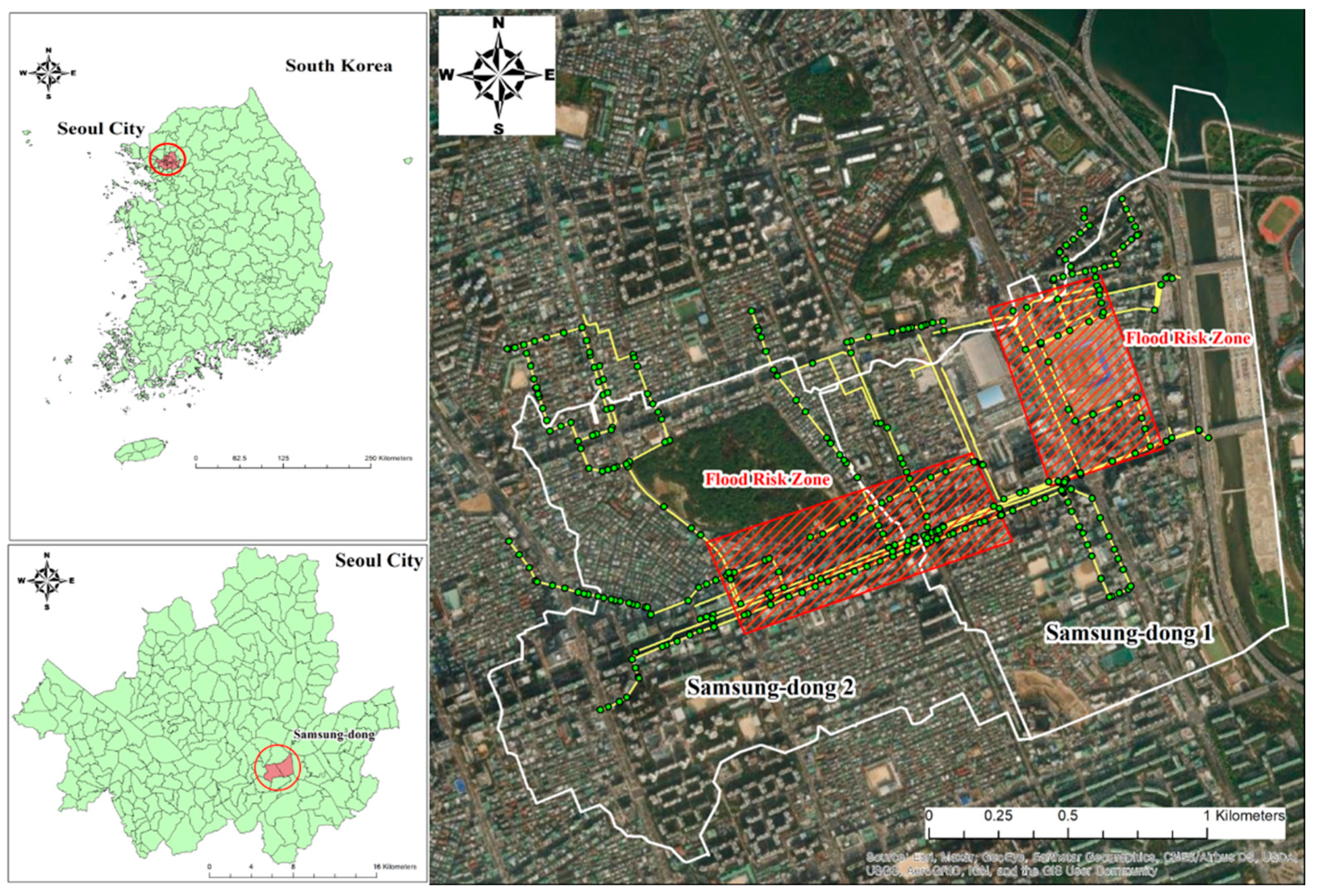
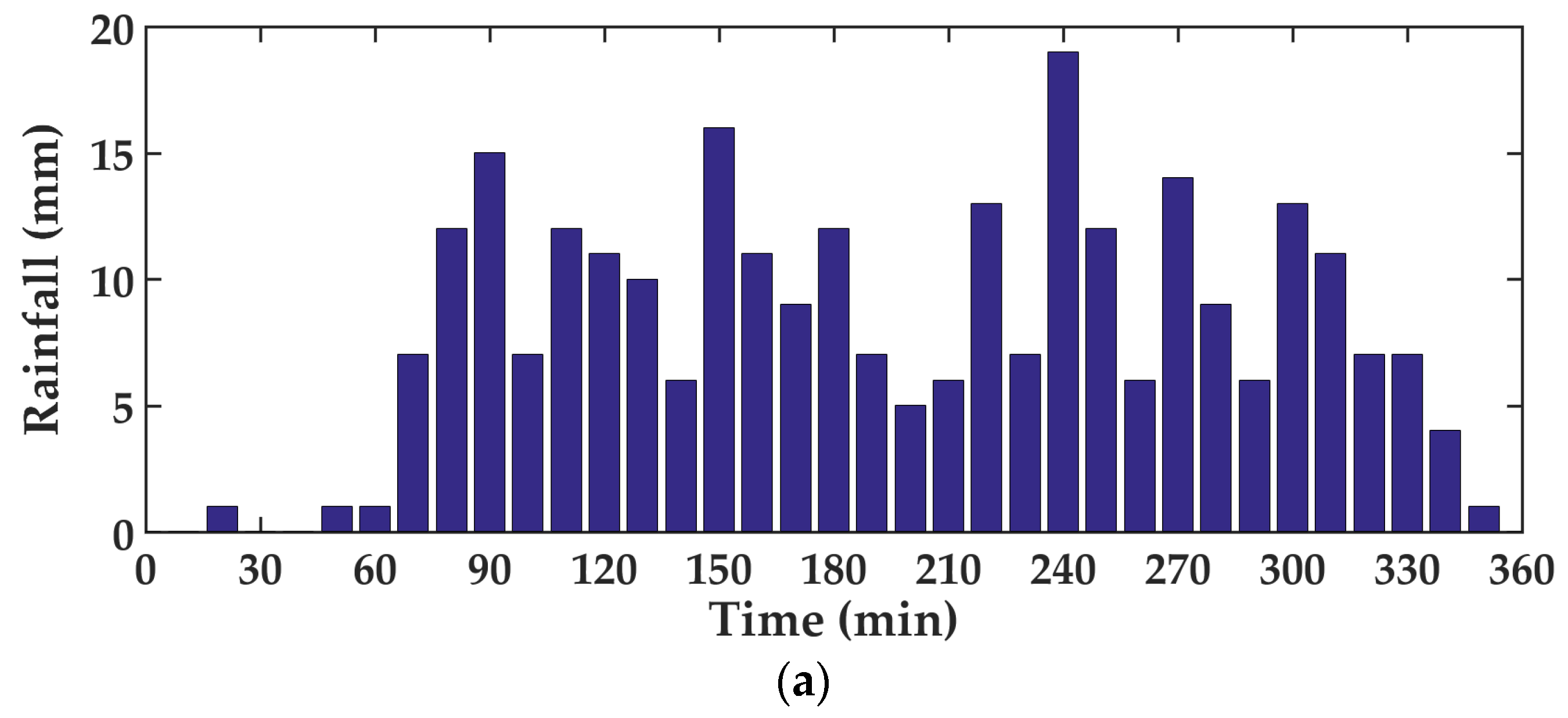
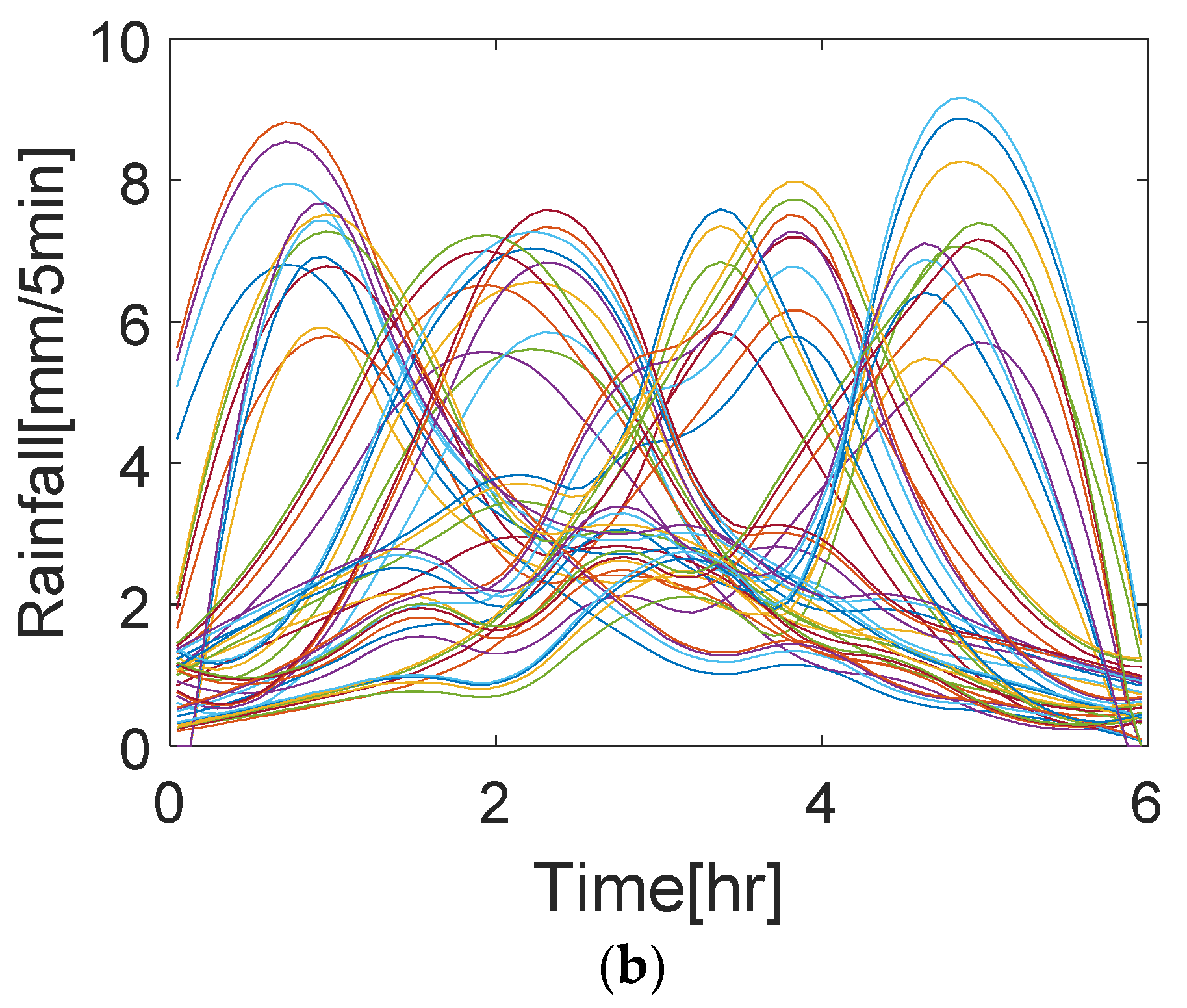

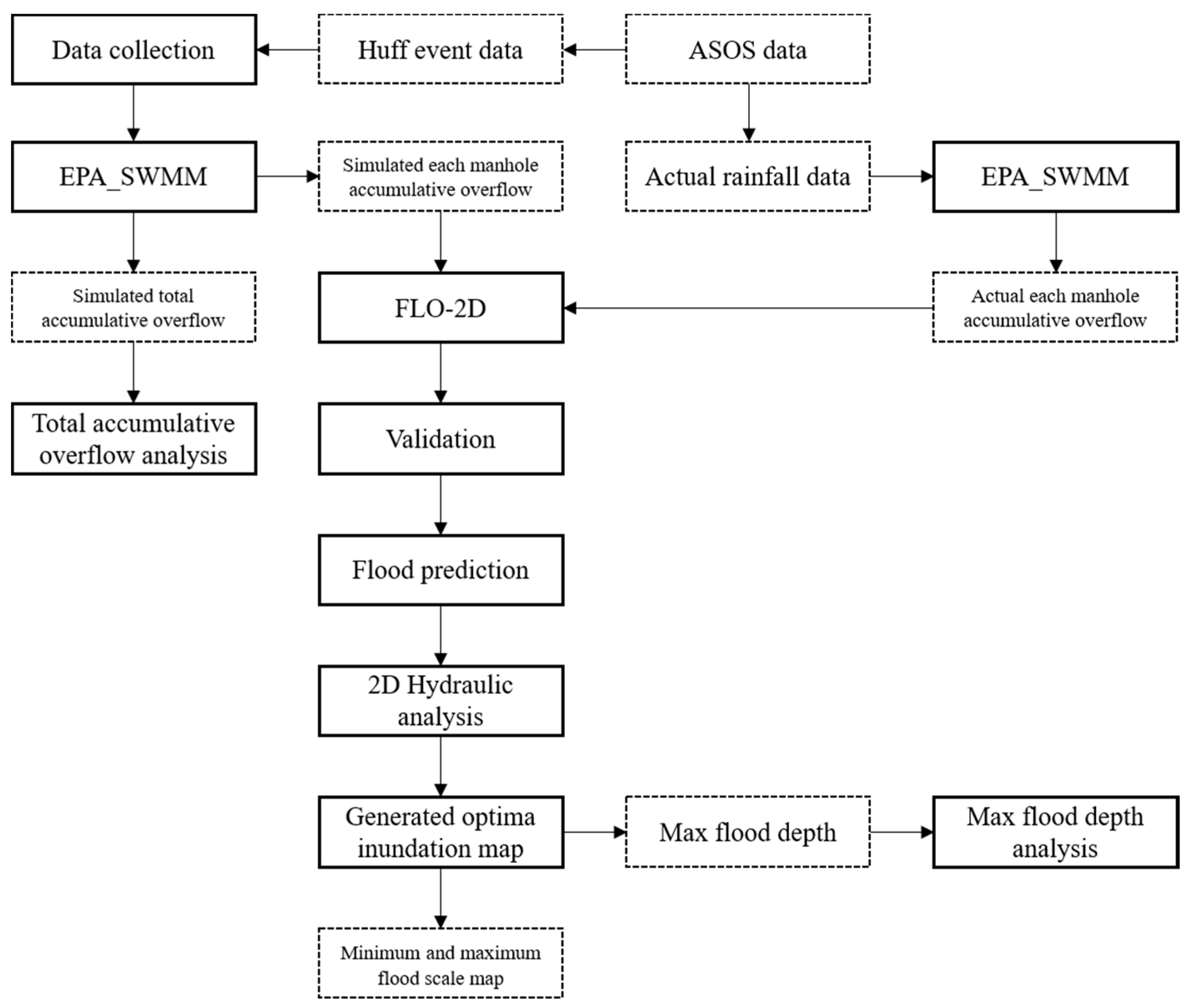
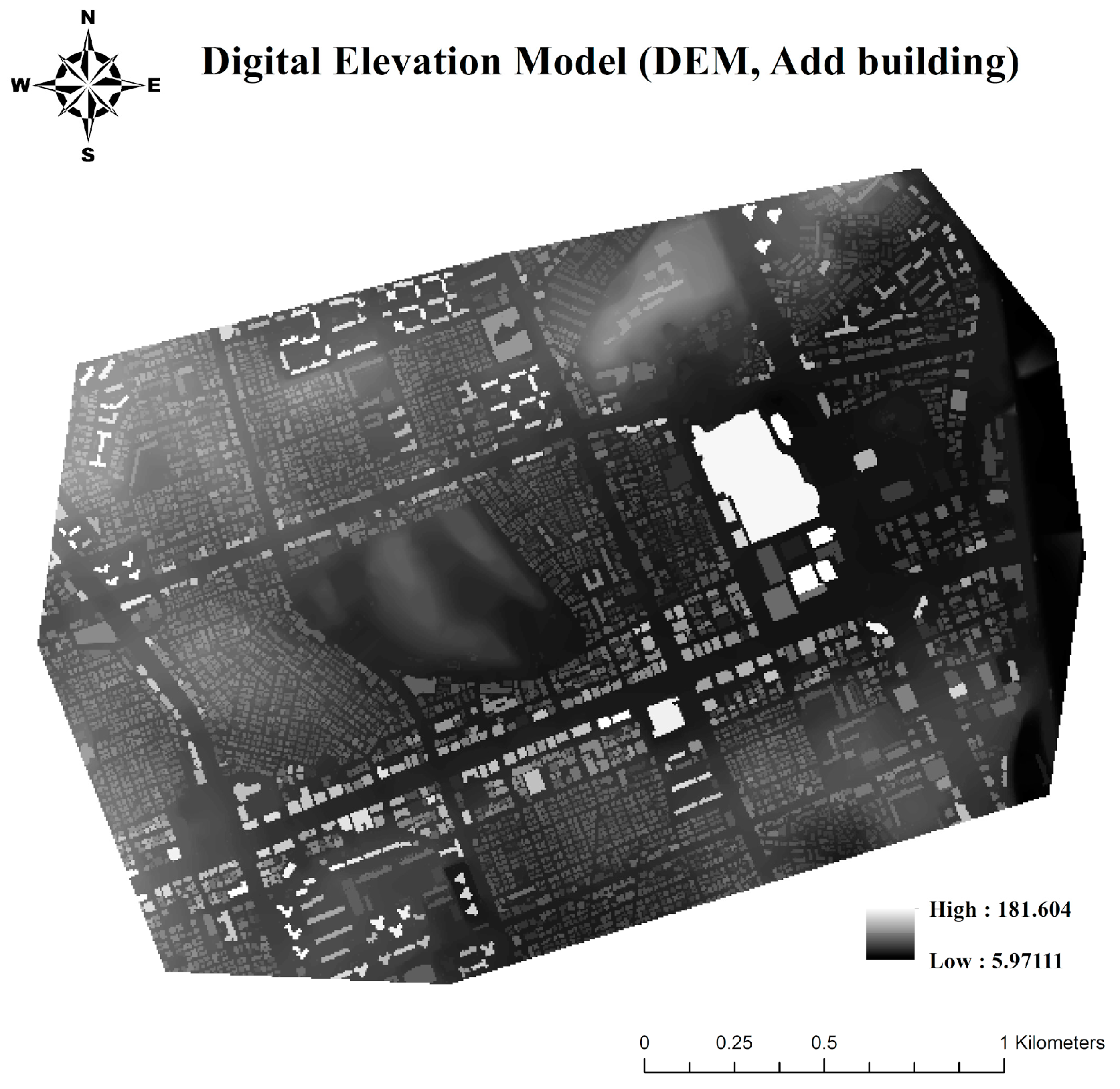
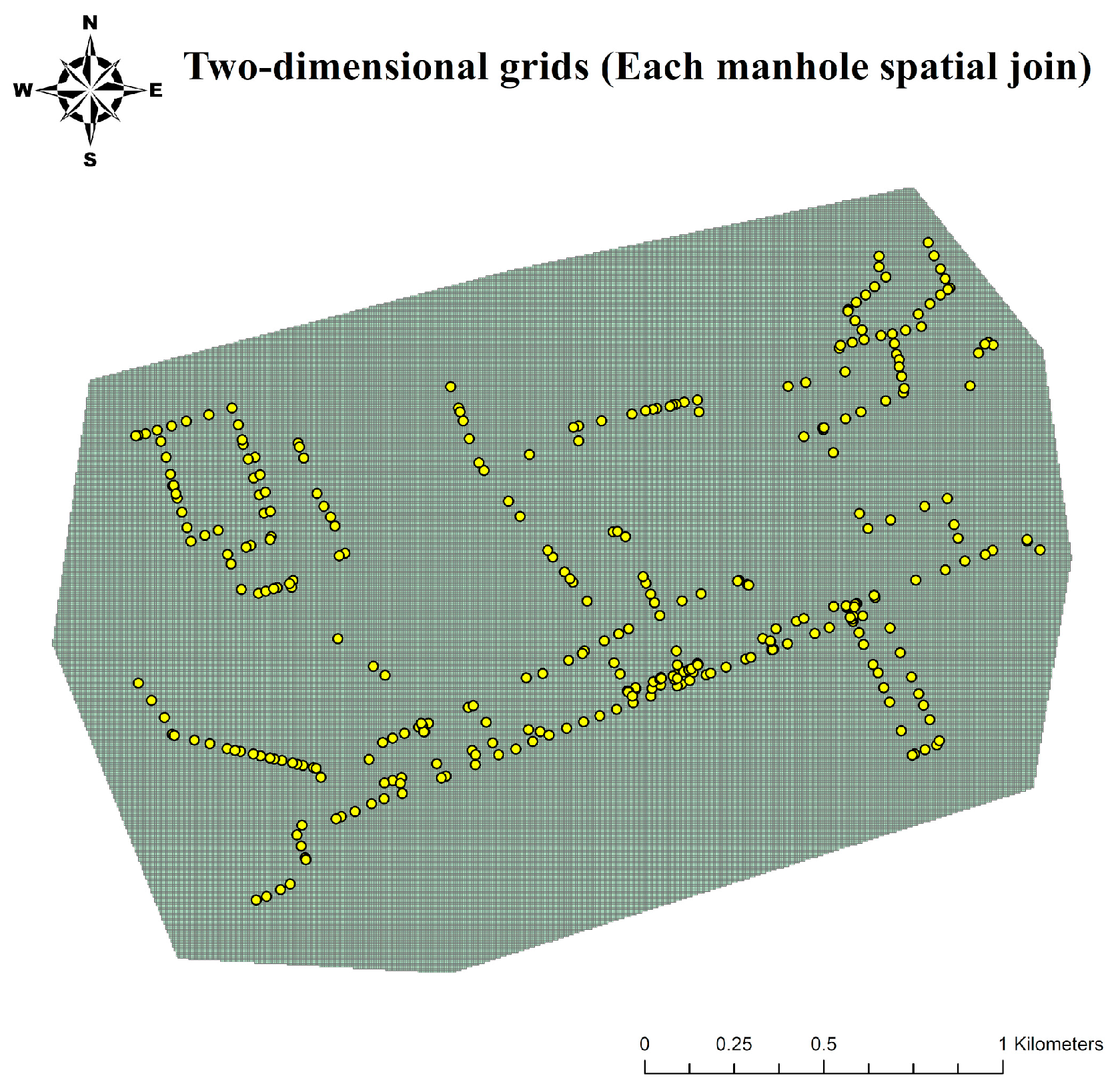
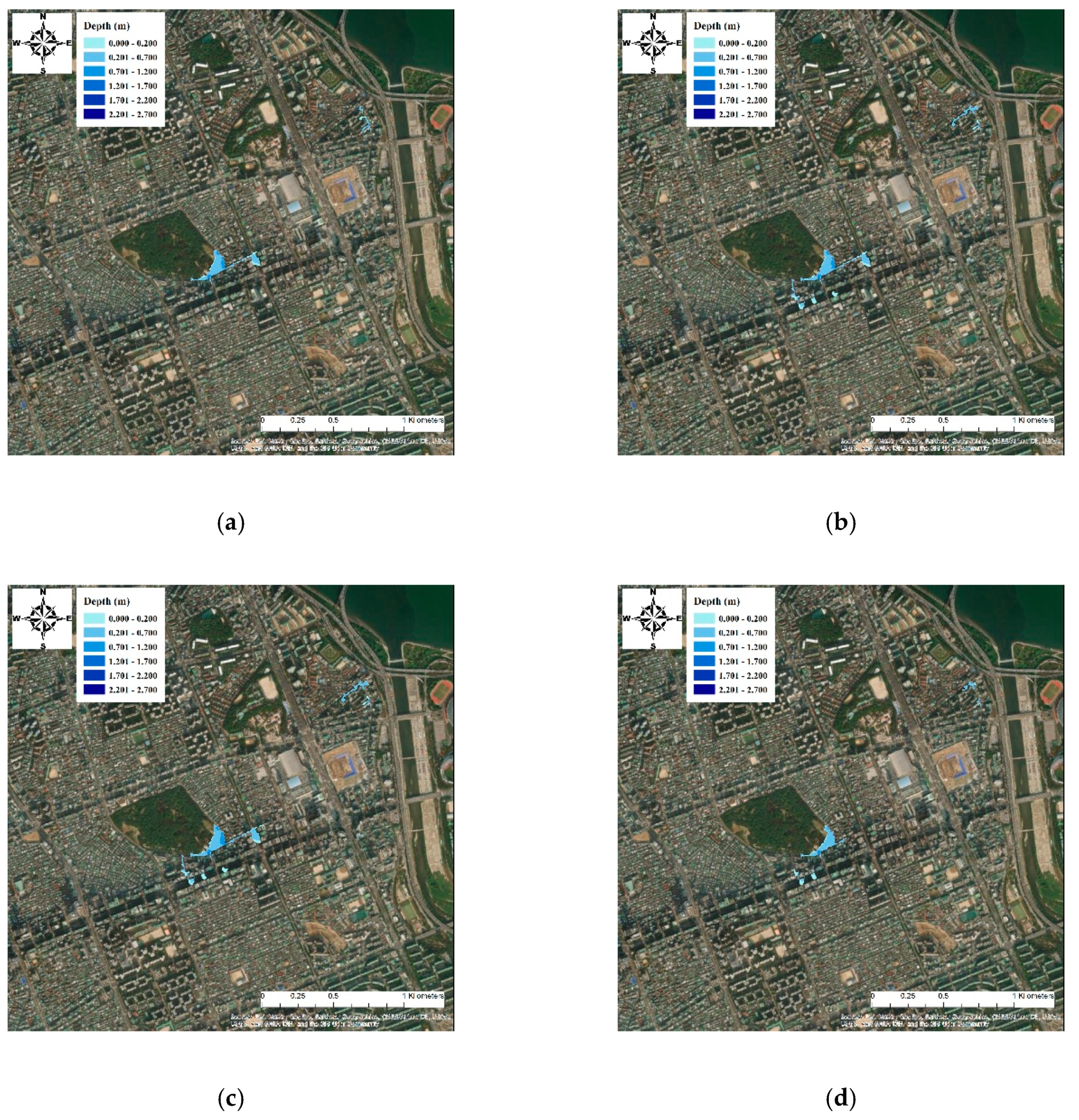
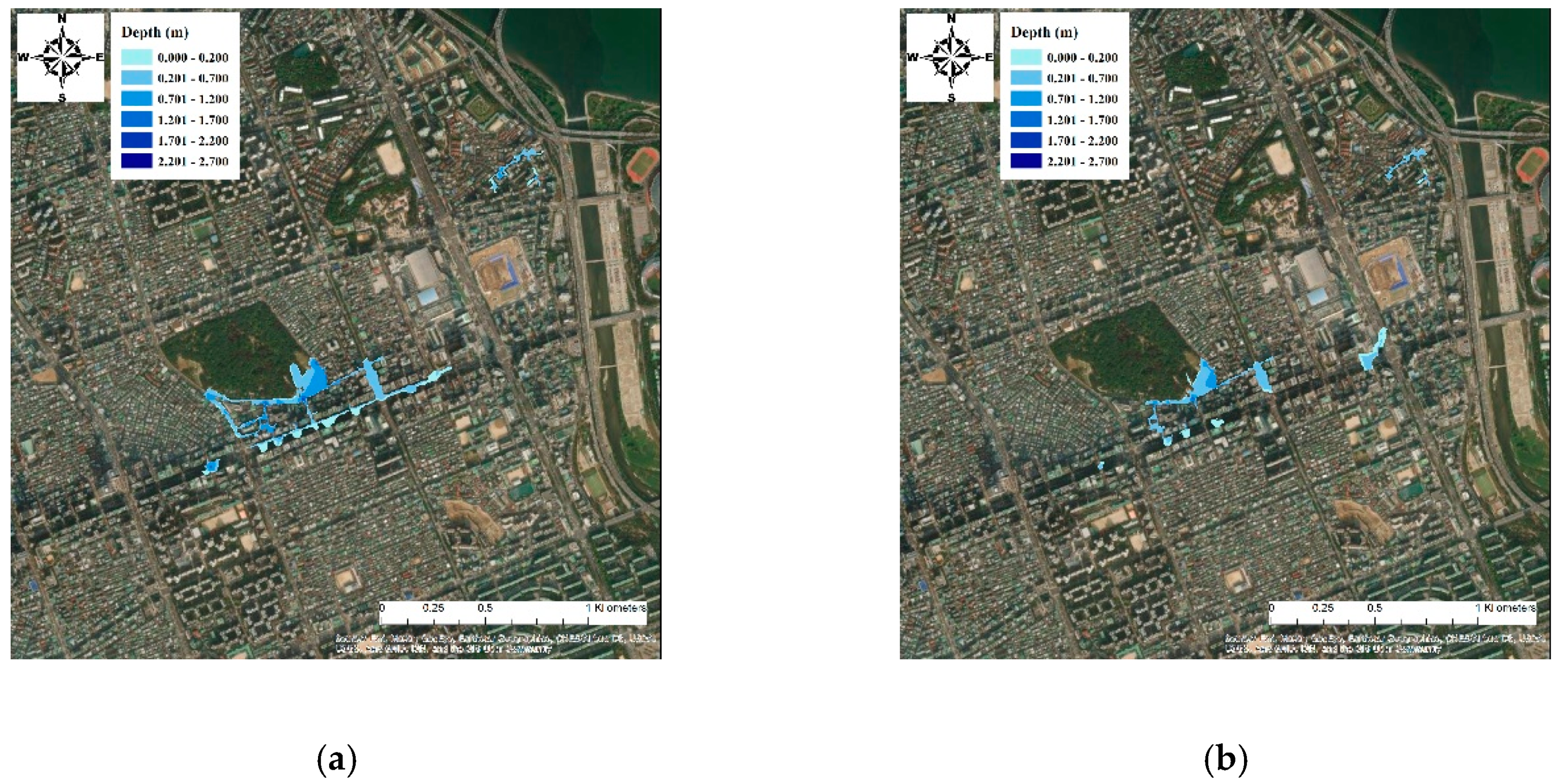
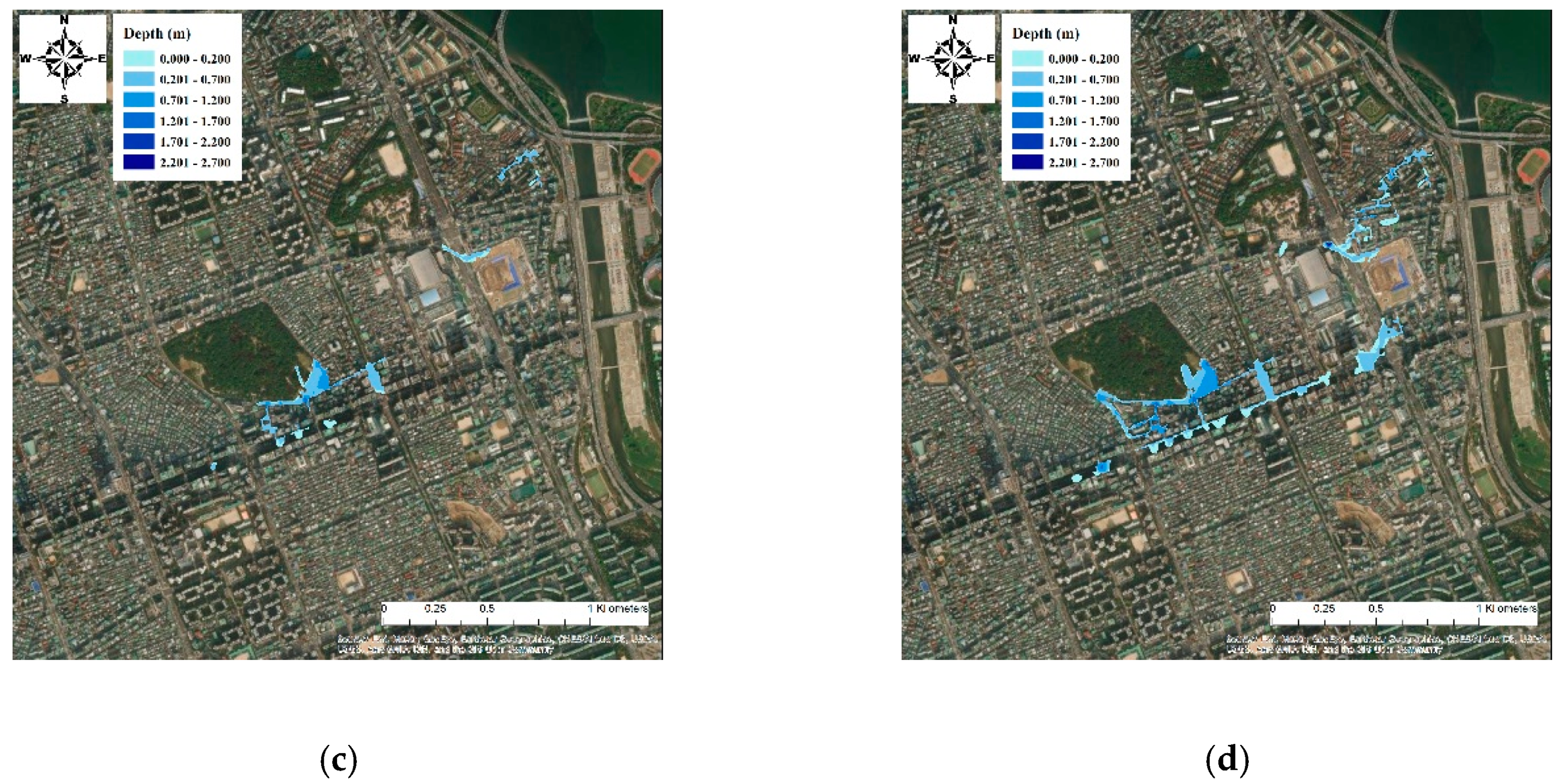
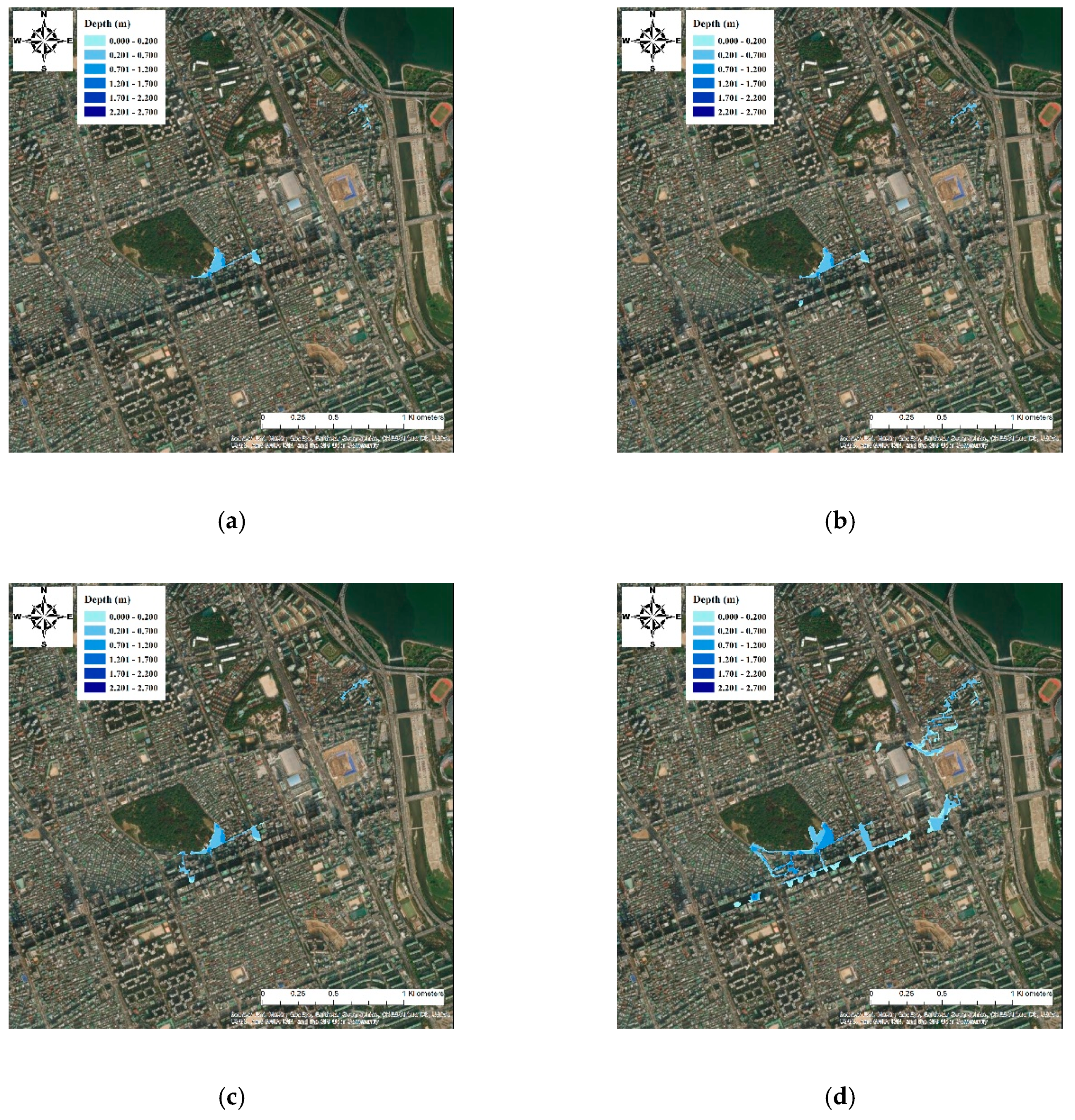
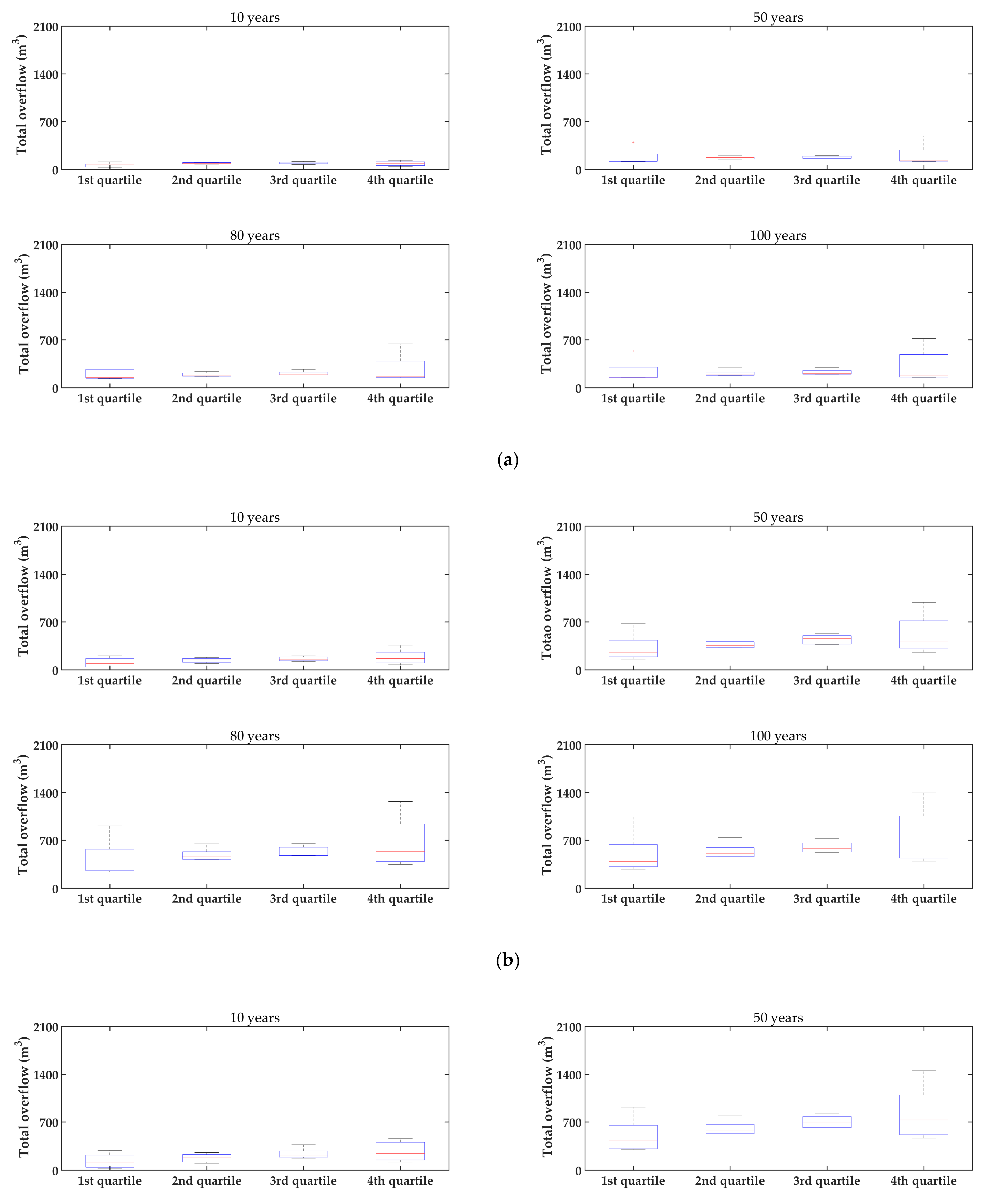

| Duration (Hour) | Total Rainfall by Periods (mm) | |||
|---|---|---|---|---|
| 10 Years | 50 Years | 80 Years | 100 Years | |
| 1 | 72.6 | 91.5 | 96.6 | 99.01 |
| 2 | 108.6 | 140.4 | 149.2 | 153.3 |
| 3 | 136.2 | 181.4 | 194.5 | 200.6 |
| Huff Quartile | Period (Year) | Total Overflow According to Different Exceedance Probabilities (m3) | Average (m3) | Minimum (m3) | Maximum (m3) | ||||||||
|---|---|---|---|---|---|---|---|---|---|---|---|---|---|
| 10% | 20% | 30% | 40% | 50% | 60% | 70% | 80% | 90% | |||||
| 1st | 10 | 110.2 | 70.2 | 74.4 | 72.7 | 67.1 | 58.9 | 46.4 | 32.0 | 22.8 | 61.6 | 22.8 | 110.2 |
| 50 | 395.0 | 206.3 | 133.3 | 118.8 | 122.8 | 129.7 | 118.3 | 117.5 | 114.3 | 161.8 | 114.3 | 395.0 | |
| 80 | 489.7 | 222.6 | 167.8 | 137.0 | 149.3 | 142.4 | 141.4 | 136.8 | 132.4 | 191.0 | 132.4 | 489.7 | |
| 100 | 536.0 | 263.9 | 180.1 | 149.8 | 153.9 | 153.1 | 149.3 | 146.6 | 156.8 | 209.9 | 146.6 | 536.0 | |
| 2nd | 10 | 102.7 | 98.9 | 101.3 | 101.0 | 84.0 | 85.1 | 82.0 | 77.9 | 74.3 | 89.7 | 74.3 | 102.7 |
| 50 | 189.9 | 187.9 | 158.0 | 156.8 | 157.9 | 140.1 | 148.6 | 201.0 | 156.1 | 166.3 | 140.1 | 201.0 | |
| 80 | 236.4 | 233.5 | 182.5 | 173.6 | 173.0 | 160.0 | 169.4 | 172.3 | 183.7 | 187.2 | 160.0 | 236.4 | |
| 100 | 290.4 | 225.9 | 192.8 | 236.2 | 186.4 | 186.0 | 179.5 | 184.0 | 201.2 | 209.2 | 179.5 | 290.4 | |
| 3rd | 10 | 71.4 | 84.0 | 89.4 | 85.9 | 93.6 | 95.8 | 93.0 | 108.0 | 115.4 | 92.9 | 71.4 | 115.4 |
| 50 | 159.6 | 168.6 | 165.8 | 162.7 | 159.5 | 170.7 | 176.8 | 200.7 | 205.8 | 174.5 | 159.5 | 205.8 | |
| 80 | 190.2 | 192.5 | 185.2 | 184.8 | 185.0 | 202.8 | 215.2 | 217.3 | 268.1 | 204.6 | 184.8 | 268.1 | |
| 100 | 207.5 | 197.4 | 196.5 | 195.7 | 206.7 | 217.3 | 232.0 | 241.8 | 296.7 | 221.3 | 195.7 | 296.7 | |
| 4th | 10 | 43.4 | 54.2 | 65.5 | 77.5 | 88.3 | 93.8 | 97.1 | 111.0 | 133.2 | 84.9 | 43.4 | 133.2 |
| 50 | 113.7 | 122.2 | 119.7 | 132.2 | 134.2 | 153.5 | 179.1 | 263.5 | 486.8 | 189.4 | 113.7 | 486.8 | |
| 80 | 139.2 | 149.1 | 153.1 | 154.8 | 167.7 | 189.7 | 241.1 | 371.7 | 639.1 | 245.1 | 139.2 | 639.1 | |
| 100 | 153.0 | 152.2 | 156.8 | 166.0 | 184.1 | 203.0 | 368.3 | 447.4 | 718.2 | 283.2 | 152.2 | 718.2 | |
| Huff Quartile | Period (Year) | Total Overflow According to Different Exceedance Probabilities (m3) | Average (m3) | Minimum (m3) | Maximum (m3) | ||||||||
|---|---|---|---|---|---|---|---|---|---|---|---|---|---|
| 10% | 20% | 30% | 40% | 50% | 60% | 70% | 80% | 90% | |||||
| 1st | 10 | 203.5 | 166.1 | 142.6 | 110.2 | 93.8 | 68.9 | 55.4 | 41.5 | 28.1 | 101.1 | 28.1 | 203.5 |
| 50 | 673.9 | 370.4 | 331.8 | 287.8 | 256.5 | 221.0 | 185.2 | 216.0 | 156.2 | 299.9 | 156.2 | 673.9 | |
| 80 | 921.6 | 489.6 | 403.7 | 386.8 | 351.8 | 322.7 | 288.1 | 232.9 | 237.0 | 403.8 | 232.9 | 921.6 | |
| 100 | 1050.6 | 549.6 | 446.0 | 426.9 | 390.0 | 374.8 | 346.6 | 303.6 | 275.5 | 462.6 | 275.5 | 1050.6 | |
| 2nd | 10 | 182.1 | 175.5 | 146.9 | 161.2 | 157.1 | 129.3 | 117.8 | 113.6 | 93.8 | 141.9 | 93.8 | 182.1 |
| 50 | 478.2 | 400.1 | 378.1 | 379.0 | 355.4 | 346.9 | 324.3 | 323.4 | 352.0 | 370.8 | 323.4 | 478.2 | |
| 80 | 656.0 | 520.9 | 463.3 | 461.0 | 466.4 | 432.5 | 419.4 | 421.0 | 442.4 | 475.9 | 419.4 | 656.0 | |
| 100 | 739.1 | 574.3 | 510.0 | 509.9 | 504.1 | 472.7 | 462.1 | 460.2 | 488.2 | 524.5 | 460.2 | 739.1 | |
| 3rd | 10 | 128.2 | 121.2 | 150.8 | 156.8 | 153.7 | 163.3 | 177.9 | 182.0 | 201.9 | 159.5 | 121.2 | 201.9 |
| 50 | 374.1 | 371.3 | 384.2 | 402.2 | 490.6 | 436.3 | 451.8 | 463.9 | 528.1 | 433.6 | 371.3 | 528.1 | |
| 80 | 507.2 | 475.6 | 482.6 | 499.1 | 531.9 | 630.2 | 556.0 | 596.3 | 652.7 | 548.0 | 475.6 | 652.7 | |
| 100 | 588.9 | 523.8 | 541.6 | 546.5 | 574.8 | 569.9 | 613.6 | 659.3 | 727.3 | 594.0 | 523.8 | 727.3 | |
| 4th | 10 | 74.3 | 99.4 | 121.0 | 148.2 | 165.6 | 178.7 | 212.2 | 231.7 | 361.5 | 177.0 | 74.3 | 361.5 |
| 50 | 255.9 | 347.8 | 326.3 | 403.9 | 418.6 | 462.8 | 590.5 | 661.9 | 985.7 | 494.8 | 255.9 | 985.7 | |
| 80 | 346.4 | 383.8 | 427.5 | 507.1 | 537.9 | 601.4 | 785.2 | 874.4 | 1266.9 | 636.7 | 346.4 | 1266.9 | |
| 100 | 394.1 | 435.7 | 473.8 | 561.5 | 584.7 | 687.7 | 888.1 | 988.0 | 1394.2 | 712.0 | 394.1 | 1394.2 | |
| Huff Quartile | Period | Total Overflow According to Different Exceedance Probabilities (m3) | Average (m3) | Minimum (m3) | Maximum (m3) | ||||||||
|---|---|---|---|---|---|---|---|---|---|---|---|---|---|
| 10% | 20% | 30% | 40% | 50% | 60% | 70% | 80% | 90% | |||||
| 1st | 10 | 286.5 | 216.6 | 176.9 | 122.5 | 105.5 | 84.9 | 56.3 | 34.8 | 27.3 | 123.5 | 27.3 | 286.5 |
| 50 | 917.3 | 601.9 | 523.1 | 480.7 | 439.2 | 395.5 | 333.9 | 298.3 | 311.0 | 477.9 | 298.3 | 917.3 | |
| 80 | 1271.4 | 746.8 | 682.7 | 611.1 | 575.8 | 532.4 | 496.7 | 463.5 | 450.9 | 647.9 | 450.9 | 1271.4 | |
| 100 | 1448.1 | 847.9 | 740.9 | 693.1 | 652.0 | 603.8 | 563.9 | 557.1 | 519.3 | 736.2 | 519.3 | 1448.1 | |
| 2nd | 10 | 256.8 | 250.3 | 183.4 | 122.5 | 178.5 | 155.4 | 132.4 | 121.3 | 100.0 | 166.7 | 100.0 | 256.8 |
| 50 | 800.9 | 634.8 | 605.9 | 584.2 | 582.8 | 566.2 | 532.4 | 528.2 | 534.4 | 596.6 | 528.2 | 800.9 | |
| 80 | 1091.2 | 900.6 | 764.5 | 755.4 | 735.5 | 729.3 | 690.0 | 661.7 | 712.9 | 782.3 | 661.7 | 1091.2 | |
| 100 | 1232.9 | 916.5 | 839.6 | 838.3 | 816.1 | 800.2 | 761.0 | 747.0 | 783.3 | 859.4 | 747.0 | 1232.9 | |
| 3rd | 10 | 174.1 | 192.3 | 194.9 | 210.9 | 220.6 | 227.6 | 236.1 | 256.5 | 371.3 | 231.6 | 174.1 | 371.3 |
| 50 | 600.4 | 619.7 | 625.9 | 650.6 | 698.7 | 700.0 | 717.9 | 810.5 | 828.7 | 694.7 | 600.4 | 828.7 | |
| 80 | 810.4 | 808.8 | 811.6 | 834.0 | 885.8 | 903.8 | 913.9 | 947.2 | 1082.0 | 888.6 | 808.8 | 1082.0 | |
| 100 | 940.2 | 907.3 | 902.5 | 911.7 | 988.2 | 998.8 | 1030.1 | 1062.5 | 1226.1 | 996.4 | 902.5 | 1226.1 | |
| 4th | 10 | 119.5 | 136.5 | 179.7 | 234.7 | 243.4 | 271.6 | 339.3 | 439.5 | 459.9 | 269.3 | 119.5 | 459.9 |
| 50 | 469.2 | 503.9 | 563.1 | 691.5 | 729.0 | 876.6 | 966.9 | 984.1 | 1456.6 | 804.5 | 469.2 | 1456.6 | |
| 80 | 633.3 | 671.3 | 725.5 | 900.7 | 944.8 | 1048.3 | 1272.5 | 1310.3 | 1847.9 | 1039.4 | 633.3 | 1847.9 | |
| 100 | 703.4 | 752.1 | 815.7 | 1013.7 | 1068.9 | 1175.0 | 1423.7 | 1484.2 | 2027.2 | 1162.7 | 703.4 | 2027.2 | |
Publisher’s Note: MDPI stays neutral with regard to jurisdictional claims in published maps and institutional affiliations. |
© 2021 by the authors. Licensee MDPI, Basel, Switzerland. This article is an open access article distributed under the terms and conditions of the Creative Commons Attribution (CC BY) license (https://creativecommons.org/licenses/by/4.0/).
Share and Cite
Li, T.; Lee, G.; Kim, G. Case Study of Urban Flood Inundation—Impact of Temporal Variability in Rainfall Events. Water 2021, 13, 3438. https://doi.org/10.3390/w13233438
Li T, Lee G, Kim G. Case Study of Urban Flood Inundation—Impact of Temporal Variability in Rainfall Events. Water. 2021; 13(23):3438. https://doi.org/10.3390/w13233438
Chicago/Turabian StyleLi, Ting, Gyuwon Lee, and Gwangseob Kim. 2021. "Case Study of Urban Flood Inundation—Impact of Temporal Variability in Rainfall Events" Water 13, no. 23: 3438. https://doi.org/10.3390/w13233438
APA StyleLi, T., Lee, G., & Kim, G. (2021). Case Study of Urban Flood Inundation—Impact of Temporal Variability in Rainfall Events. Water, 13(23), 3438. https://doi.org/10.3390/w13233438






